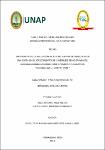| dc.contributor.advisor | Mora del Águila, Félix Maximiliano | |
| dc.contributor.author | Inga Valles, Dalia Cecibel | |
| dc.contributor.author | Shapiama Gonzales, Karen Isabel | |
| dc.date.accessioned | 2020-02-06T14:58:09Z | |
| dc.date.available | 2020-02-06T14:58:09Z | |
| dc.date.issued | 2019 | |
| dc.identifier.other | 639.34 I53 2019 | |
| dc.identifier.uri | http://repositorio.unapiquitos.edu.pe/handle/20.500.12737/6696 | |
| dc.description.abstract | Con el objetivo de evaluar la influencia de la inclusión de 10% de harina de insectos en una dieta sobre el crecimiento de juveniles de acarahuazú, Astronotus ocellatus, se realizó el presente estudio en las instalaciones de la Empresa “ALEVINOS VALENTINA” en la ciudad de Yurimaguas, provincia Alto Amazonas, departamento de Loreto; para tal fin se compararon dos dietas como tratamientos, con cuatro repeticiones cada una. El primer tratamiento (T1:10%HI) comprendió una mezcla de insumos tradicionales (harina de pescado, torta de soya, harina de maíz, polvillo de arroz y Aceite Vegetal) + 10% de harina de insectos, y el segundo tratamiento (T2:0%HI) o tratamiento control, solamente con los insumos tradicionales. Las unidades experimentales estuvieron conformadas por 10 juveniles de acarahuazú, con tallas y pesos totales promedios de 2.32 cm y 0.58 g, respectivamente, sembrados en peceras de vidrio con medidas de 70 x 40 x 40 cm. Los parámetros biológicos de ganancia de peso (GP), incremento en peso (IP), tasa de crecimiento específico (TCE), conversión alimenticia aparente (CAA), eficiencia alimenticia (EA), coeficiente de variación de peso (CVP), y tasa de sobrevivencia (S), fueron los indicadores que permitieron determinar el efecto de la alimentación. Los peces alimentados con la dieta con inclusión de harina de insectos (T1:10%HI) lograron mayor ganancia de peso (GP=7.76+-0.26), mayor incremento en peso (IP=1314.18+-84.90), mejor tasa de crecimiento específico (TCE=2.94+-0.07), mejor conversión alimenticia (CAA=2.05+-0.06) y mejor eficiencia alimenticia (EA=49.03+-1.39), marcando diferencia significativa (p<0.05) con respecto de los peces alimentados con la dieta sin harina de insectos (T2:0%HI). Con relación al coeficiente de variación del peso (T1=9.91+-4.46 y T2=8.86+-3.41) y la supervivencia (T1=75.0 y T2=72.5), las aparentes diferencias no marcan significancia (p>0.05). Estos resultados nos llevan a concluir que el acarahuazú, Astronotus ocellatus, aprovecha muy bien la harina de insectos, y que este insumo puede ser utilizado en fórmulas para alimentarlos en pequeños. | es_PE |
| dc.description.abstract | With the objective of evaluating the influence of the inclusion of 10% of insect flour in a diet on the growth of acarahuazú juveniles, Astronotus ocellatus, the present study was carried out in the facilities of the Company “ALEVINOS VALENTINA” in the city of Yurimaguas, Alto Amazonas province, Loreto department; To this end, two diets were compared as treatments, with four repetitions each. The first treatment (T1: 10% HI) comprised a mixture of traditional inputs (fishmeal, soybean cake, cornmeal, rice powder and Vegetable Oil) + 10% insect flour, and the second treatment (T2 : 0% HI) or control treatment, only traditional inputs. The experimental units were made up of 10 juveniles of acarahuazú, with average total sizes and weights of 2.32 cm and 0.58 g, respectively, planted in glass tanks with measures of 70 x 40 x 40 cm. Biological parameters of weight gain (GP), increase in weight (IP), specific growth rate (TCE), apparent food conversion (CAA), food efficiency (EA), weight variation coefficient (CVP), and rate Survival (S), were the indicators that allowed to determine the effect of feeding. Fish fed with the diet including insect flour (T1: 10% HI) achieved greater weight gain (GP = 7.76+-0.26), greater increase in weight (IP = 1314.18+-84.90), better specific growth rate ( TCE = 2.94+-0.07), better feed conversion (CAA = 2.05+-0.06) and better feed efficiency (EA = 49.03+-1.39), making a significant difference (p <0.05) with respect to fish fed with the diet without insect flour (T2: 0% HI). In relation to the coefficient of variation of the weight (T1 = 9.91+-4.46 and T2 = 8.86+-3.41) and survival (T1 = 75.0 and T2 = 72.5), the apparent differences do not mark significance (p> 0.05). These results lead us to conclude that acarahuazú, Astronotus ocellatus, makes good use of insect flour, and that this input can be used in formulas to feed them in small. | en_US |
| dc.description.uri | Tesis | es_PE |
| dc.format | application/pdf | es_PE |
| dc.language.iso | spa | es_PE |
| dc.publisher | Universidad Nacional de la Amazonía Peruana | es_PE |
| dc.rights | info:eu-repo/semantics/openAccess | es_PE |
| dc.rights | Attribution-NonCommercial-NoDerivs 3.0 United States | * |
| dc.rights.uri | http://creativecommons.org/licenses/by-nc-nd/3.0/us/ | * |
| dc.source | Universidad Nacional de la Amazonía Peruana | es_PE |
| dc.source | Repositorio institucional - UNAP | es_PE |
| dc.subject | Alimentación de peces | es_PE |
| dc.subject | Harina animal | es_PE |
| dc.subject | Raciones alimenticias | es_PE |
| dc.subject | Acarahuazú | es_PE |
| dc.subject | Astronotus ocellatus | es_PE |
| dc.subject | Acuarios | es_PE |
| dc.title | Influencia de la inclusión al 10% de harina de insectos en una dieta en el crecimiento de juveniles de acarahuazú, Astronotus ocellatus (Agassiz, 1831) criados en acuarios, Yurimaguas – Loreto, 2019 | es_PE |
| dc.type | info:eu-repo/semantics/bachelorThesis | es_PE |
| thesis.degree.discipline | Acuicultura | es_PE |
| thesis.degree.grantor | Universidad Nacional de la Amazonía Peruana. Facultad de Ciencias Biológicas | es_PE |
| thesis.degree.level | Título Profesional | es_PE |
| thesis.degree.name | Biólogo(a) Acuicultor(a) | es_PE |
| thesis.degree.program | Presencial | es_PE |
| dc.subject.ocde | Biología Marina y del Agua | es_PE |
| dc.subject.ocde | http://purl.org/pe-repo/ocde/ford#1.06.12 | es_PE |


